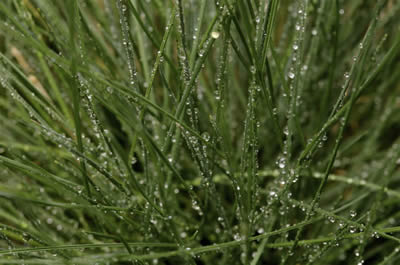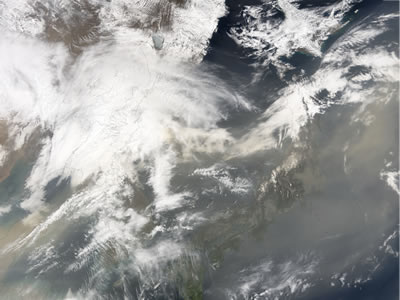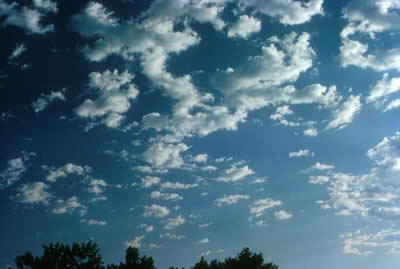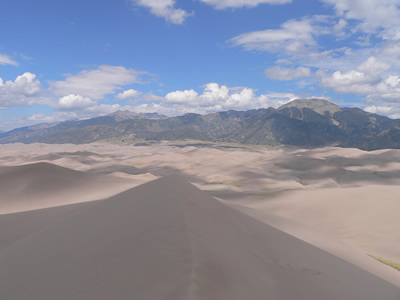View of cumulus clouds from the Great Sand Dunes National Park and Preserve near Alamosa, Colorado.
Click on image for full size
Courtesy of Olga and Sergei Kuznetsov
How Clouds Form
A cloud is composed of tiny water droplets or ice crystals. A series of things have to happen in order for these water droplets or ice crystals to form into clouds in the atmosphere, and different types of clouds form in different ways. The four main ways that clouds can form are:
All of these processes involve the cooling of air. Warm air is able to hold larger amounts of water vapor than cool air, so when air cools it can't hold as much water vapor as when it was warm. This extra water vapor begins to condense out of the air into liquid water droplets.
Water vapor usually needs some sort of particle, such as dust or pollen, to condense upon. These particles are called condensation nuclei. Eventually, enough water vapor will condense upon condensation nuclei to form a cloud. The water droplets in the cloud may eventually fall down to Earth in the form of rain or snow (or other forms of precipitation).
You might also be interested in:

Weather fronts can cause clouds to form. Fronts happen when two large masses of air collide into each other at the Earth's surface. Warm fronts produce clouds when warm air replaces cold air by sliding
...more
Condensation is when water changes its state from a vapor or gas to a liquid. Condensation is responsible for the formation of clouds. Common examples of condensation are: dew forming on grass in the early
...more
When you look up at the sky, you are looking at more than just air. There are also billions of tiny bits of solid and liquid floating in the air. These tiny particles are called aerosols or particulates.
...more
Raindrops form when tiny water droplets collide together in clouds to form bigger ones. When they get too heavy, rain falls out of the clouds. Rain is more than 5mm in diameter. The types of clouds that
...more
In order for clouds to form, water droplets in the atmosphere need a surface to condense upon. There are millions of tiny particles floating in the air that can provide this surface, and these particles
...more
Altocumulus clouds are part of the Middle Cloud group. They are grayish-white with one part of the cloud darker than the other. Altocumulus clouds usually form in groups. Altocumulus clouds are about
...more
Altostratus clouds belong to the Middle Cloud group. An altostratus cloud usually covers the whole sky. The cloud looks gray or blue-gray. The sun or moon may shine through an altostratus cloud, but will
...more















